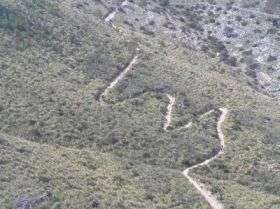In the race to the top, zigzagging is more efficient than a straight line

A straight line may be the shortest distance between two points, but it isn’t necessarily the fastest or easiest path to follow.
That’s particularly true when terrain is not level, and now American and British researchers have developed a mathematical model showing that a zigzag course provides the most efficient way for humans to go up or down steep slopes.
“I think zigzagging is something people do intuitively,” said Marcos Llobera, a University of Washington assistant professor of anthropology who is a landscape archaeologist. “People recognize that zigzagging, or switchbacks, help but they don’t realize why they came about.”
Llobera, who is interested in reconstructing patterns of movement within past landscapes, said the model and a study that describes it stem from earlier research that looked at the emergence of trail systems. That research focused on flat terrain.
“You would expect a similar process on any landscape, but when you have changes in elevation it makes things more complicated,” he said. “There is a point, or critical slope, where it becomes metabolically too costly to go straight ahead, so people move at an angle, cutting into the slope. Eventually they need to go back toward the direction they were originally headed and this creates zigzags. The steeper the slope, the more important it is that you tackle it at the right angle.”
Trails evolve, among other reasons, because of physical differences in people and the differences in the biomechanics and energy cost of ascending and descending a slope.
“You get a different pattern if people are going up or down and this may lead to the emergence of shortcuts. Walking downhill generally takes less energy except for braking. We would expect to see different paths going up and down, but what we end up with is a compromise and shortcuts aren’t as apparent.”
Llobera said many other physical factors can influence the creation and development of a trail or path, and that the new model is a simplified one and a place to start. Eventually he hopes to build a simulation engine that would allow archaeologists to plug in a terrain and explore different patterns of movement through it. He is particularly interested in using it with landscapes that have resulted from the accumulations of various societies and cultures.
The study appears the Journal of Theoretical Biology.
Source: University of Washington





















